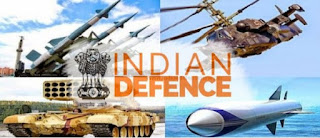INDIA BECOMING ATMANIRBHAR IN ITS OWN SECURITY
Atmanirbhar Bharat, a clarion call given by Prime Minister Narendra Modi, seeks to put India on a path of self-reliance and self-sufficiency, making India a bigger and more important part of the global economy by pursuing policies that are efficient, competitive and resilient, as well as being self-sustaining and generating. Government decisions have been taken as part of this campaign, such as changing the definition of MSMEs, boosting the scope for private participation in numerous sectors, increasing FDI in the defence sector etc. The Government has opened up the defence industry for private sector participation to provide impetus to indigenous manufacturing which will also paw the way for foreign original equipment manufacturers to enter into strategic partnerships with Indian companies.

SIGNIFICANCE OF THE DEFENCE SECTOR
By carrying out the national defence, national interests are protected by the active involvement of state institutions with responsibilities in the field, but not only these, being committed to the available resources of the state in order to ensure sovereignty, independence, unity, and territorial integrity. Over the period of time, the guns improved and weapons became more accurate. Machine guns, grenades and cannons were popular among the troops and were being used in wars. Explosive shells that killed a group become even more common and accurate creating high-level casualties.
Indian defence forces have embraced technology with open arms and have made tremendous progress in the last two decades. With a continual focus on building a formidable defence infrastructure, India has built a series of expansive and secure defence networks across tri-forces including a robust cyber and space command (DCA & DSA). These essentially form the communication backbone of the forces and the launchpad for the next generation of defence networks, but enhancement in the areas of jointness technology led Security Solution and Intelligence, Surveillance and Reconnaissance (ISR), interoperability and cyber security are now imperative.
Hindustan Aeronautics Limited (HAL) is the top defence manufacturer in India. It has a significant history of manufacturing aircraft, engines, helicopters and related equipment and accessories. MARUT, TEJAS, SU-30MKI, LCA, DHRUV, and LUA are some of the aircraft and helicopters manufactured by HAL. With approx 1.4 million active personnel, India has the world’s 2nd largest military force. During the last three and a half years, the government has taken a number of policy-based initiatives to boost indigenous defence production, technology upgradation and defence export capabilities.
INDIAN ECONOMY AND DEFENCE SECTOR
Arms import decreased by 33% between 2011-15 and 2016-20 while India continues to remain the second largest arms importer after Saudi Arabia according to a report from Swedish think-tank Stockholm International Peace Research Institute (SIPRI). In 2020, India with third largest annual defence budget (US 706) behind the USA (US 7326) and China (US $2616) and the second largest defence importer behind Saudi Arabia making up 9.2% of global arms imports, also of which is government owned Public Sector including Defence Research and Development Organisation (DRDO) and its 50 labs, 4 defence shipyards, 5 defence PSUs and 41 ordnance factories, has come up with new draft- 2020 Defence Manufacturing Policy to reduce imports and enhance domestic manufacturing. The Government of India has decided to set up two Defence Production corridors, one each in Uttar Pradesh and one in Tamil Nadu.

CHALLENGES IN THE DEFENCE SECTOR
India faces a whole range of complex challenges in its defence modernization aspirations, which are aimed at containing the threats that it perceives to be having severe implications for its national security. This is mainly due to; a declining defence budget towards long-term investment, research and development process inefficiencies and delays in domestic production by government-lead organisations; and the government’s reluctance to grant defence contracts to India’s private sector. There is an absence of a clear policy, a lack of accountability for defence public sector units and a perennial fund crunch which poses a great challenge for ‘Make In India ‘ in the defence sector. Issues related to stringent labour laws, compliance burden and lack of skills affect manufacturing in defence. Due to this, India hasn’t been able to attract FDI in defence. Overlapping jurisdiction of the industrial promotion impairs India’s capability of defence manufacturing.
STEPS TAKEN BY THE GOVERNMENT
The Chief of Defence Staff (CDS) could examine the acquisition from a tri-service angle, this may avoid delays and speed up the defence procurement process. Introduction of various categories of defence projects such as ‘Buy Indian-IDDM (Indigenously Designed, Developed and Manufactured)’, ‘Buy Indian’, ‘Buy Global-Manufacture in India’, ‘Buy Global’ and likely to boost the PSU as well as private industry. Liberalised and transparent policy for granting Industrial licences will attract private players. The government of India banned the import of 101 defence items to boost indigenous production in consonance with the Modi government’s Atmanirbhar Bharat. Innovation for Defence Excellence (IDEX) has also been launched and its objective is to bring startups to innovate, develop technology and solve problems related to defence and aerospace. The initiative is being implemented by Defence Innovation Organization (DIO), a Section 8 company founded by BEL and HAL. DIO initiated activities in 2018/2019 like running Defence India Startup challenges (DISCs) and outreach activities to activate the Indian Startup ecosystem for defence.
CONCLUSION
Self-reliance in defence manufacturing is a crucial component of effective defence capability and achieving military superiority. The attainment of this will ensure strategic independence, and cost-effective defence equipment and may lead to saving on the defence import bills, which can subsequently finance the physical and social infrastructure.

